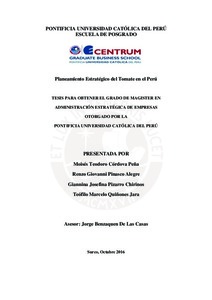| dc.contributor.advisor | Benzaquen de las Casas, Jorge Benny | |
| dc.contributor.author | Córdova Peña, Moisés Teodoro | es_ES |
| dc.contributor.author | Pinasco Alegre, Renzo Giovanni | es_ES |
| dc.contributor.author | Pizarro Chirinos, Giannina Josefina | es_ES |
| dc.contributor.author | Quiñones Jara, Teófilo Marcelo | es_ES |
| dc.date.accessioned | 2016-11-28T21:06:00Z | |
| dc.date.available | 2016-11-28T21:06:00Z | |
| dc.date.created | 2016 | |
| dc.date.issued | 2016 | |
| dc.identifier.uri | http://hdl.handle.net/20.500.12404/7519 | |
| dc.description.abstract | El Planeamiento Estratégico del Tomate del Perú, tiene como enfoque primordial alcanzar la visión trazada para el desarrollo de la industria del tomate y sus derivados en el país al 2026, el cual se origina producto de la interacción de dos pilares fundamentales del plan estratégico: (a) los objetivos de largo plazo; y (b) las estrategias a aplicar. Dichos pilares antes indicados son resultados obtenidos en base a una perspectiva analítica de información filtrada y visitas a campo, que ha permitido definir: (a) el análisis externo identificando los principales referentes y competidores en el cultivo de tomates y producción de derivados tanto en la región sudamericana así como en el mundo; y (b) el análisis interno definiendo las principales regiones potenciales productoras de tomate del país tales como Ica, Lima y Arequipa; dicho contexto real ha sido obtenido mediante el análisis FODA empleado de la citada industria en el país, cuyo origen se sustenta mediante el diagnóstico de la situación actual del cultivo del tomate y la producción de sus derivados en el país desde hace unas décadas hasta la fecha.
El desarrollo del cultivo del tomate en el país, constituye una oportunidad para promover su exportación a nivel de Sudamérica en principio proyectado a otros mercados internacionales a futuro, dado a que el mercado interno se encuentra cubierto para ello es indispensable que los órganos competentes gubernamentales y privados desarrollen investigación y desarrollo enfocado al control de plagas tales como la mosca de la fruta, incremento de productividad y motivación en los productores en la formación de clúster de producción del tomate en el país sectorizados por zonas norte, centro y sur. Explotar las ventajas comparativas que posee el país relacionada a la variedad climática y condiciones de zonas de cultivo que garantizan producción durante todo el años de manera alternada, el cual brinda sostenibilidad a la producción del tomate durante todo el año, siendo elemento diferenciador respecto a los competidores directos de Chile y Argentina | es_ES |
| dc.description.abstract | The strategic planning for Peru´s tomato has, as its primary focus, to achieve the outlined vision for the development of its industry and its derivatives in 2026. This focus originates as a product of the interaction of two pillars of the strategic plan: (a) long-term objectives; and (b) development and implementation of strategies. These two pillars are the result of an analytical perspective of filtered information and field trips, which have allowed us to identify, as a product of an external and internal analysis of the industry, (a) the main players and competitors in the cultivation and production of tomatoes and its derivatives both in the South American region and in the whole world, (b) the major tomato producing regions of the country such as Ica, Lima and Arequipa, (c) the assessment of the real situation of the Peruvian tomato industry, (d) its strengths and weaknesses and (e) the principal elements of its value chain.
All of this was obtained using different analytical tools like the PESTE analysis and Porter´s diamond as part of the formulation process of the industry´s strategic planning.
With all of this information, we can conclude that the development of the cultivation of the tomato in the country constitutes an interesting opportunity to promote its exports at a South America level and then to other international markets in the near future, being both of them far more attractive than the local market as its demand is already satisfied by the actual local producers of fresh tomatoes in the country.
In order to achieve these goals, it is of the utmost importance that the designated governmental entities and the private sector begin developing and researching new pest control methods as a way to increase productivity along the coastal region, exploiting its comparative advantages related to climate and all year-round supply, giving a differentiating edge over direct competitors like Chile and Argentina. | es_ES |
| dc.language.iso | spa | es_ES |
| dc.publisher | Pontificia Universidad Católica del Perú | es_ES |
| dc.rights | Atribución-NoComercial-SinDerivadas 2.5 Perú | * |
| dc.rights | info:eu-repo/semantics/openAccess | es_ES |
| dc.rights.uri | http://creativecommons.org/licenses/by-nc-nd/2.5/pe/ | * |
| dc.subject | Tomates--Industria y comercio--Perú | es_ES |
| dc.subject | Planificación estratégica | es_ES |
| dc.title | Planeamiento estratégico del tomate en el Perú | es_ES |
| dc.type | info:eu-repo/semantics/masterThesis | es_ES |
| thesis.degree.name | Magíster en Administración Estratégica de Empresas | es_ES |
| thesis.degree.level | Maestría | es_ES |
| thesis.degree.grantor | Pontificia Universidad Católica del Perú. CENTRUM | es_ES |
| thesis.degree.discipline | Administración Estratégica de Empresas | es_ES |
| renati.advisor.dni | 42800984 | |
| renati.advisor.orcid | https://orcid.org/0000-0001-8098-6401 | es_ES |
| renati.discipline | 413307 | es_ES |
| renati.level | https://purl.org/pe-repo/renati/level#maestro | es_ES |
| renati.type | https://purl.org/pe-repo/renati/type#tesis | es_ES |
| dc.publisher.country | PE | es_ES |
| dc.subject.ocde | https://purl.org/pe-repo/ocde/ford#5.02.04 | es_ES |






